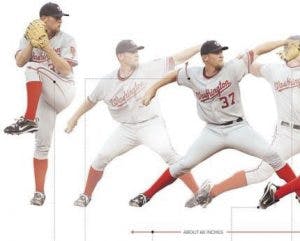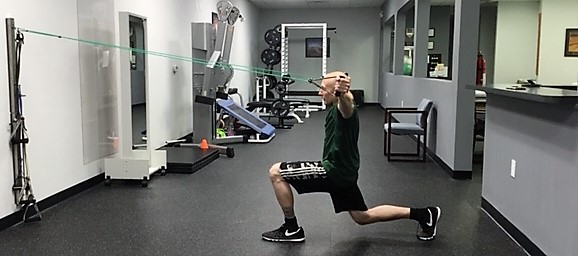Overhead activities such as throwing require proper sequencing of different body parts. The lower body, trunk, shoulder, arm, and hands are considered links in a chain. If any of these links are not functioning properly, the chain is broken. Effectively using the body as a kinetic chain maximizes overhead athletic performance and reduces injury risk. This article describes how shoulder rehabilitation programs now integrate the kinetic chain theory for a broader approach versus focusing only on isolated muscles.
Why Involve the Kinetic Chain?
Exercises targeting the shoulder muscles receive a great deal of attention in overhead athletes and rightfully so. The rotator cuff and scapular muscles are important for dissipating high forces created during throwing. However, most of the energy created during throwing occurs from the lower body and trunk. Weak links in the lower body lead to additional stress to the shoulder and elbow during throwing. Therefore, including exercises that incorporate all links of the kinetic chain is beneficial.

Lower body exercises such as the squat and lunge can be integrated with common shoulder rehab exercises. Total body exercises that incorporate resistance bands or tubing are ideal for integrating links of the kinetic chain. This article described only 3 exercise examples. However, there are many other variations that can be developed based on the athlete’s profile and goals.
Overhead Squat with “Y”
Stand holding a resistance band in both hands with your shoulders flexed and elbows straight. Perform an overhead “Y” by raising both hands with your elbows straight. Maintain this overhead “Y” position as you perform an overhead squat. Try to reach a maximum depth of the squat without compromising your upper-body position. Maintain the overhead “Y” until completing your set. Perform 8 to 10 repetitions in each set. This exercise integrates your gluteus maximus, rotator cuff, low back muscles, and trapezius.
Lunge with “T”
Stand holding a resistance band in both hands with your shoulders flexed and elbows straight. Perform a “T” with both arms by pulling your hands and shoulder blades back with your elbow straight. Once in the “T” position, perform a reverse lunge with one leg. The “T” position is maintained until one alternating repetition is performed on each leg. Reset the “T” before completing your next repetition. Perform 6 to 8 slow and controlled repetitions on each side. This exercise activates your gluteus medius, gluteus maximus, lats, and trapezius.
Lateral Band Walk with “W”
Perform an exaggerated sideways walk with a resistance band just above your knees. Remain in an athletic position keeping your toes pointed straight ahead. Push your knees apart against the resistance band to activate your hip muscles.
Your shoulder blade and rotator cuff muscles are activated by using a second resistance band in your hands. Make a “W” with the elbows to achieve scapular retraction. Take 3 steps to the right followed by 3 steps back to the starting position. Also, think about pulling the elbows to your opposite back pocket. Perform 6 to 8 slow and controlled repetitions to each side. This exercise activates your gluteus medius, gluteus maximus, rotator cuff, and lower trapezius.
Learn the Kinetic Chain Exercises Best for You
Combining lower body exercises with traditional shoulder rehabilitation exercises is beneficial for overhead athletes. Muscles throughout the entire body function in a coordinated sequence during baseball and softball throwing. Resistance bands have gained popularity in the baseball and softball communities as part of pre-throwing routines and strength and conditioning programs. These shoulder-focused exercises train only a limited number of links in the kinetic chain. A wise approach is to integrate upper-body resistance band exercises with dynamic, full-body exercises.
Talk to your physical therapist or give us a call if you are unsure about which exercises are best for you.


